Plant-Based Burgers Commercialized in the Spanish Market: Ingredients and Nutritional Assessment Based on Their Labels
Abstract
1. Introduction
2. Materials and Methods
3. Results and Discussion
3.1. Ingredients
3.2. Nutritional Aspects
4. Conclusions
Author Contributions
Funding
Institutional Review Board Statement
Informed Consent Statement
Data Availability Statement
Conflicts of Interest
References
- Astiasarán, I.; Giura, L.; Ansorena, D. Functional, Nutritional and Commercial Aspects of Plant-Based Proteins as Alternative for Meat Products Analogues. A Review. An. Real Acad. Nac. Farm. 2022, 88, 543–554. [Google Scholar] [CrossRef]
- Ariz, I.; Ansorena, D.; Astiasaran, I. In Vitro Digestion of Beef and Vegan Burgers Cooked by Microwave Technology: Effects on Protein and Lipid Fractions. Food Res. Int. 2024, 186, 114376. [Google Scholar] [CrossRef] [PubMed]
- GFI Plant-Based Retail Sales in Six European Countries, 2022 to 2024. Available online: https://gfieurope.org/european-plant-based-sales-data/ (accessed on 20 June 2025).
- Sultan, L.; Maganinho, M.; Padrão, P. Comparative Assessment of the Nutritional Composition and Degree of Processing of Meat Products and Their Plant-Based Analogues. J. Food Compos. Anal. 2024, 133, 106390. [Google Scholar] [CrossRef]
- Tyndall, S.M.; Maloney, G.R.; Cole, M.B.; Hazell, N.G.; Augustin, M.A. Critical Food and Nutrition Science Challenges for Plant-Based Meat Alternative Products. Crit. Rev. Food Sci. Nutr. 2024, 64, 638–653. [Google Scholar] [CrossRef]
- Baig, M.A.; Ajayi, F.F.; Hamdi, M.; Baba, W.; Brishti, F.H.; Khalid, N.; Zhou, W.; Maqsood, S. Recent Research Advances in Meat Analogues: A Comprehensive Review on Production, Protein Sources, Quality Attributes, Analytical Techniques Used, and Consumer Perception. Food Rev. Int. 2025, 41, 236–267. [Google Scholar] [CrossRef]
- Jang, J.; Lee, D.-W. Advancements in Plant Based Meat Analogs Enhancing Sensory and Nutritional Attributes. NPJ Sci. Food 2024, 8, 50. [Google Scholar] [CrossRef]
- Lee, S.Y.; Lee, D.Y.; Hur, S.J. Future Perspectives: Current Trends and Controversies of Meat Alternatives Classified as Ultra-Processed Foods. J. Food Sci. 2024, 89, 7022–7033. [Google Scholar] [CrossRef]
- Ariz-Hernandez, I.; Astiasaran, I.; Ansorena, D. Plant-Based Burgers: Effects of Protein Source, Type of Extrusion and Cooking Technology on Oxidation Status and in Vitro Digestibility. Future Foods 2025, 12, 100712. [Google Scholar] [CrossRef]
- Martín-Miguélez, J.M.; Martín, I.; González-Mohíno, A.; Souza Olegario, L.; Peromingo, B.; Delgado, J. Ultra-Processed Plant-Based Analogs: Addressing the Challenging Journey toward Health and Safety. J. Food Sci. 2024, 89, 10344–10362. [Google Scholar] [CrossRef]
- El Sadig, R.; Wu, J. Are Novel Plant-Based Meat Alternatives the Healthier Choice? Food Res. Int. 2024, 183, 114184. [Google Scholar] [CrossRef]
- Shireen, A.; Wright, A.J. The Meat of the Matter: Plant-Based Meat Analogue versus Traditional Meat Product Nutritional Quality. Food Sci. Hum. Wellness 2024, 13, 3110–3125. [Google Scholar] [CrossRef]
- Boachie, R.T.; Aluko, R.E. Plant-Based Meat Analogues: Processing, Product Safety, Protein Quality, and Contributions to Environmental Sustainability. Sustain. Food Proteins 2025, 3, e70018. [Google Scholar] [CrossRef]
- Cutroneo, S.; Angelino, D.; Tedeschi, T.; Pellegrini, N.; Martini, D. Nutritional Quality of Meat Analogues: Results from the Food Labelling of Italian Products (FLIP) Project. Front. Nutr. 2022, 9, 852831. [Google Scholar] [CrossRef]
- Valero, T.; del Pozo, S.; Ruiz, E.; Ávila, J.M.; Varela, G. Guía Nutricional de La Carne; Fundación Española de la Nutrición: Madrid, Spain, 2012. [Google Scholar]
- Costa-Catala, J.; Toro-Funes, N.; Comas-Basté, O.; Hernández-Macias, S.; Sánchez-Pérez, S.; Latorre-Moratalla, M.L.; Veciana-Nogués, M.T.; Castell-Garralda, V.; Vidal-Carou, M.C. Comparative Assessment of the Nutritional Profile of Meat Products and Their Plant-Based Analogues. Nutrients 2023, 15, 2807. [Google Scholar] [CrossRef] [PubMed]
- Birke Rune, C.J.; Song, Q.; Clausen, M.P.; Giacalone, D. Consumer Perception of Plant-Based Burger Recipes Studied by Projective Mapping. Future Foods 2022, 6, 100168. [Google Scholar] [CrossRef]
- Wang, Y.; Lyu, B.; Fu, H.; Li, J.; Ji, L.; Gong, H.; Zhang, R.; Liu, J.; Yu, H. The Development Process of Plant-Based Meat Alternatives: Raw Material Formulations and Processing Strategies. Food Res. Int. 2023, 167, 112689. [Google Scholar] [CrossRef] [PubMed]
- Peñaranda, I.; Morales, M.B.L.; Garrido, M.D.; Egea, M. Plant-Based Burgers with Reduced Texture Additives: A Comparative Study of Methylcellulose and Sodium Alginate. Foods 2025, 14, 1373. [Google Scholar] [CrossRef]
- Choi, H.W.; Jeon, H.; Lee, J.Y.; Choi, Y.J.; Hahn, J. Mechanical Stretching Technology for Plant-Based Meat Analogs with Enhanced Texture Utilizing Wheat Gluten and Pea Protein Isolate. LWT 2025, 218, 117479. [Google Scholar] [CrossRef]
- Zhang, R.; Yang, Y.; Liu, Q.; Xu, L.; Bao, H.; Ren, X.; Jin, Z.; Jiao, A. Effect of Wheat Gluten and Peanut Protein Ratio on the Moisture Distribution and Textural Quality of High-Moisture Extruded Meat Analogs from an Extruder Response Perspective. Foods 2023, 12, 1696. [Google Scholar] [CrossRef]
- Rizzolo-Brime, L.; Orta-Ramirez, A.; Puyol Martin, Y.; Jakszyn, P. Nutritional Assessment of Plant-Based Meat Alternatives: A Comparison of Nutritional Information of Plant-Based Meat Alternatives in Spanish Supermarkets. Nutrients 2023, 15, 1325. [Google Scholar] [CrossRef]
- Zhou, H.; Vu, G.; Gong, X.; McClements, D.J. Comparison of the Cooking Behaviors of Meat and Plant-Based Meat Analogues: Appearance, Texture, and Fluid Holding Properties. ACS Food Sci. Technol. 2022, 2, 844–851. [Google Scholar] [CrossRef]
- Biazotto, K.R.; Xavier, A.C.H.; de Mattos, R.R.; Furlan, J.M.; Wagner, R.; Bandoni, D.H.; de Rosso, V.V. Plant-Based Burgers in the Spotlight: A Detailed Composition Evaluation and Comprehensive Discussion on Nutrient Adequacy. Foods 2025, 14, 372. [Google Scholar] [CrossRef]
- Curtain, F.; Grafenauer, S. Plant-Based Meat Substitutes in the Flexitarian Age: An Audit of Products on Supermarket Shelves. Nutrients 2019, 11, 2603. [Google Scholar] [CrossRef] [PubMed]
- Bryngelsson, S.; Moshtaghian, H.; Bianchi, M.; Hallström, E. Nutritional Assessment of Plant-Based Meat Analogues on the Swedish Market. Int. J. Food Sci. Nutr. 2022, 73, 889–901. [Google Scholar] [CrossRef] [PubMed]
- Filip, C.; Kovács, B.; Miklos, A.; Pop, P.N.; Istrate, T.; Hodoroga, V.; Tero-vescan, A. Comparative Analysis of the Nutritional Quality of Plant-Based and Traditional Meat Products across European Markets. Front. Nutr. 2025, 12, 1603600. [Google Scholar] [CrossRef]
- Regulation (EC). No 1924/2006 of the European Parliament and of the Council of 20 December 2006 on Nutrition and Health Claims Made on Foods. Off. J. Eur. Union 2006, 404, 9–25. [Google Scholar]
- Lima, D.C.; Noguera, N.H.; Rezende-de-Souza, J.H.; Pflanzer, S.B. What Are Brazilian Plant-Based Meat Products Delivering to Consumers? A Look at the Ingredients, Allergens, Label Claims, and Nutritional Value. J. Food Compos. Anal. 2023, 121, 105406. [Google Scholar] [CrossRef]
- Oh, S.; Lee, D.Y.; Kim, D.; Jung, Y.; Hur, S.J.; Jang, A. Comparative Analysis of the Nutritional and Sensory Profiles of Commercial Processed Meat Products Made from Beef and Plant-Based Protein. Nutrients 2025, 17, 1771. [Google Scholar] [CrossRef]
- Xie, Y.; Cai, L.; Zhou, G.; Li, C. Comparison of Nutritional Profile between Plant-Based Meat Analogues and Real Meat: A Review Focusing on Ingredients, Nutrient Contents, Bioavailability, and Health Impacts. Food Res. Int. 2024, 187, 114460. [Google Scholar] [CrossRef]
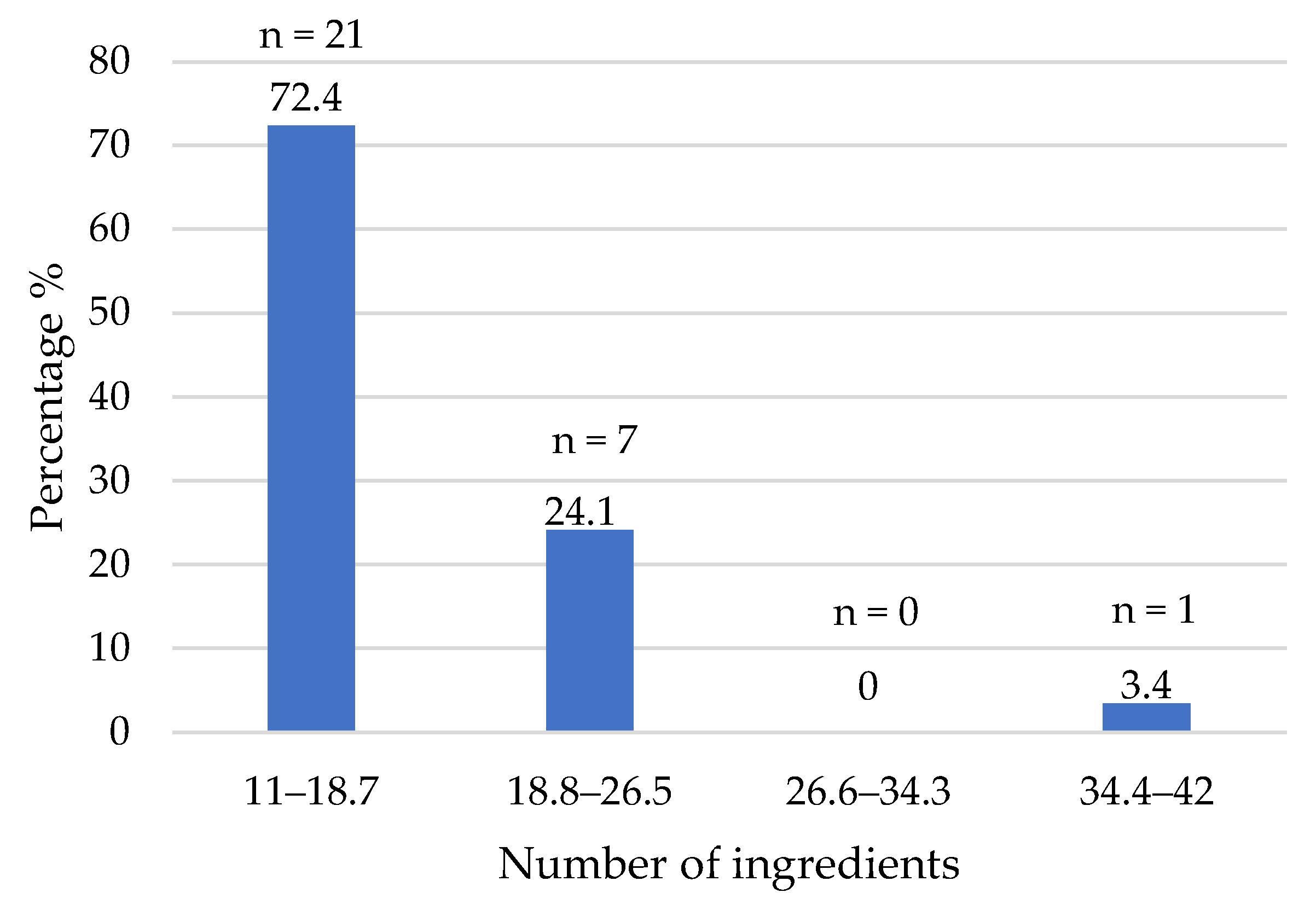
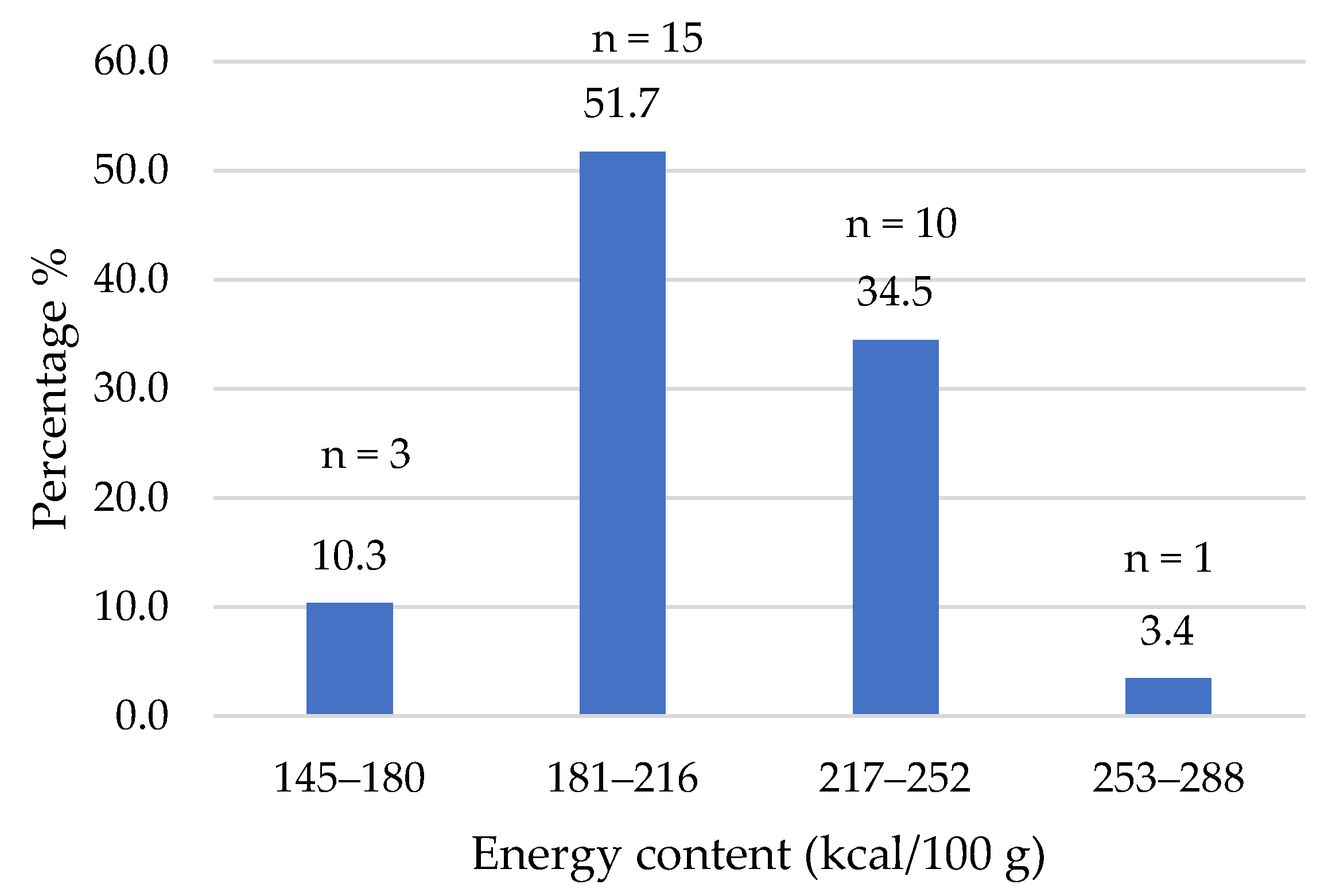
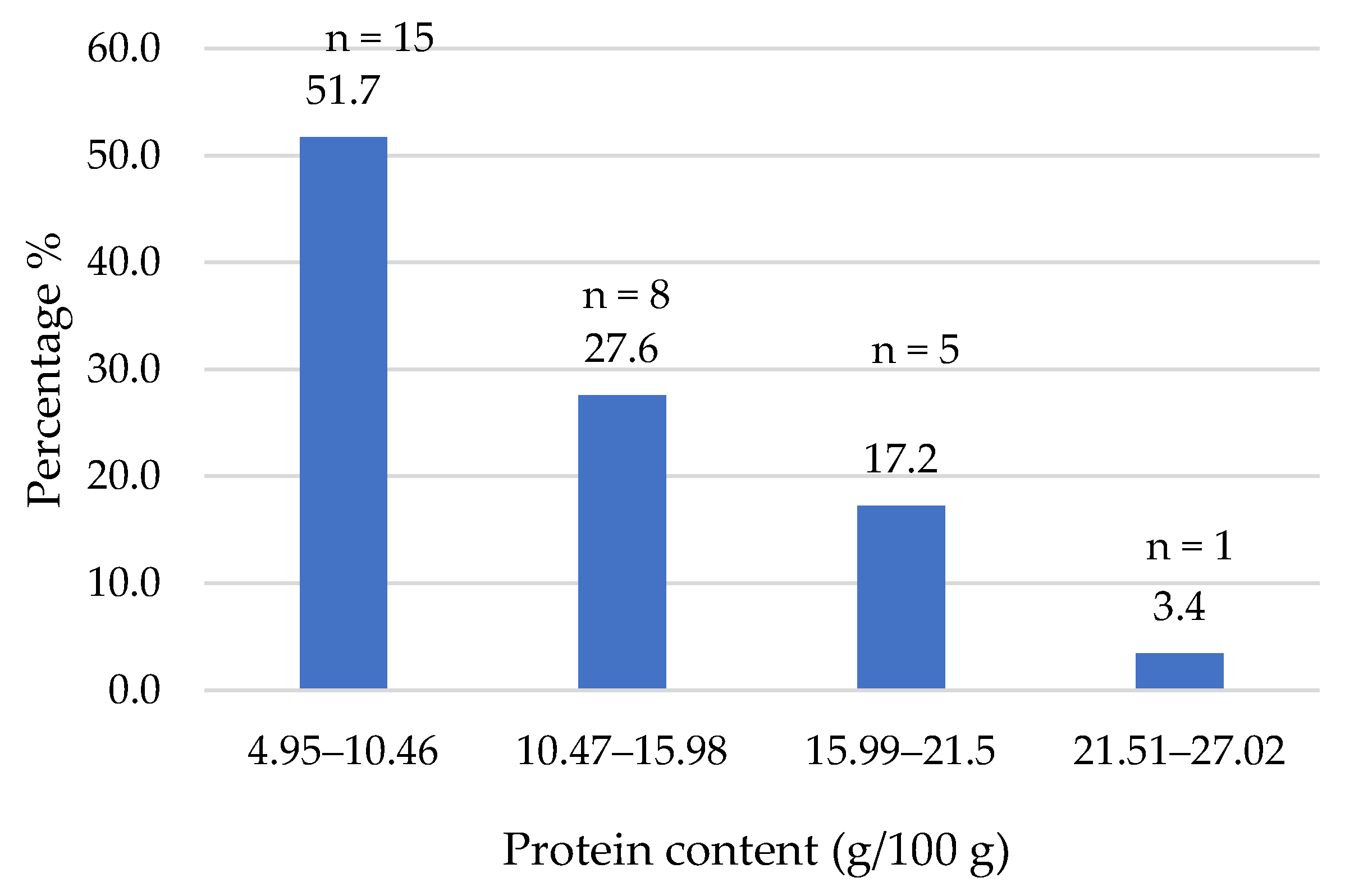
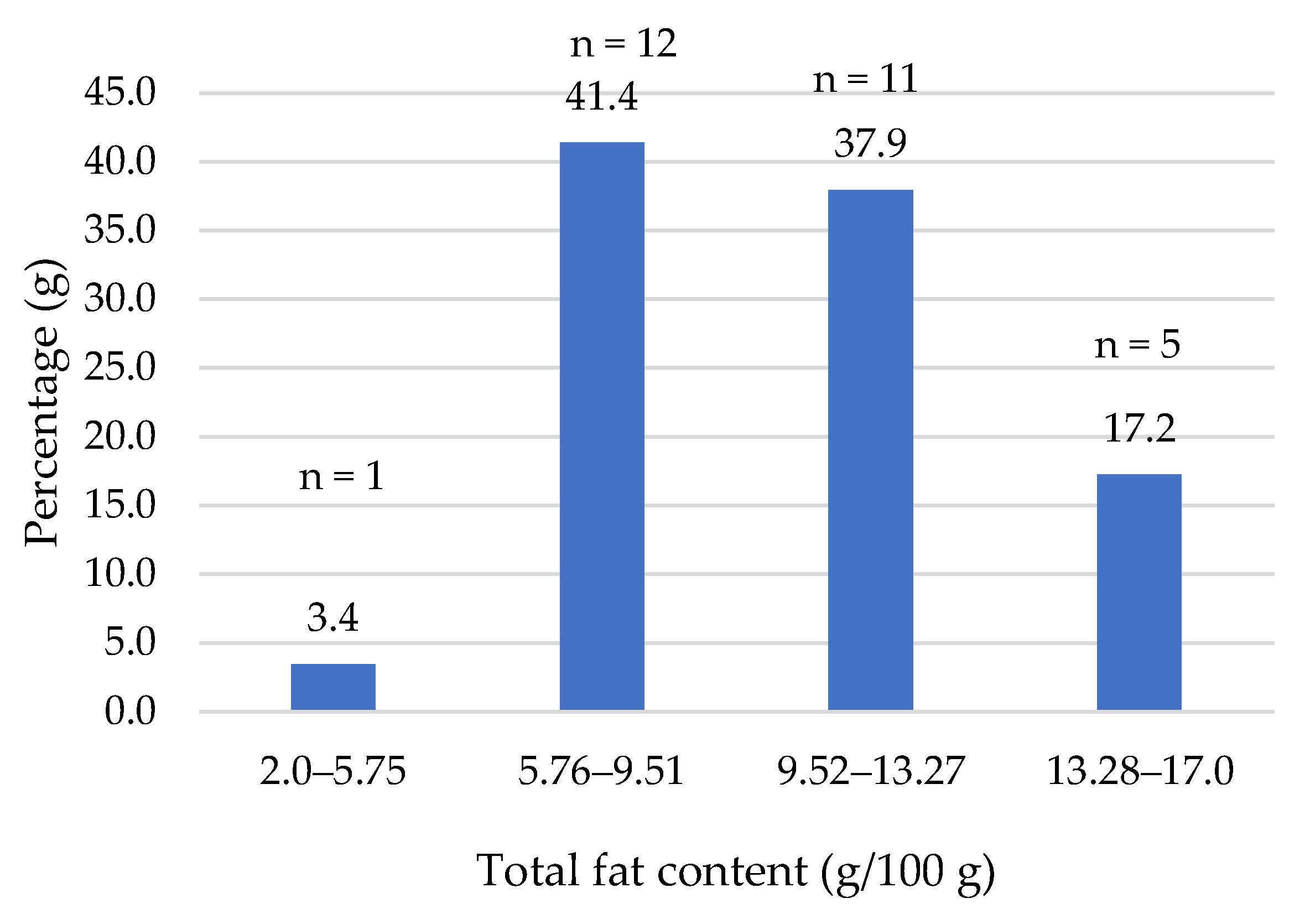

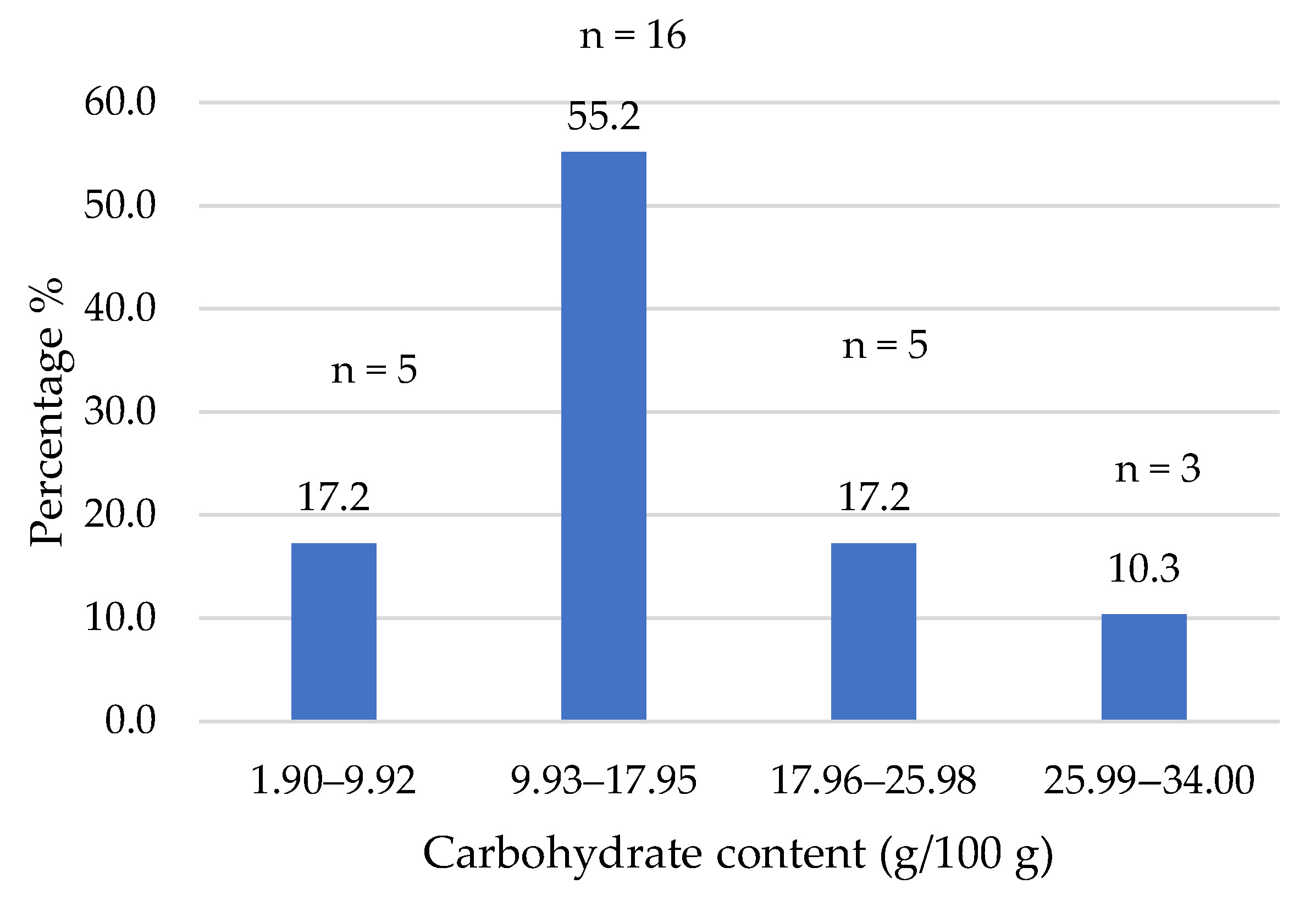
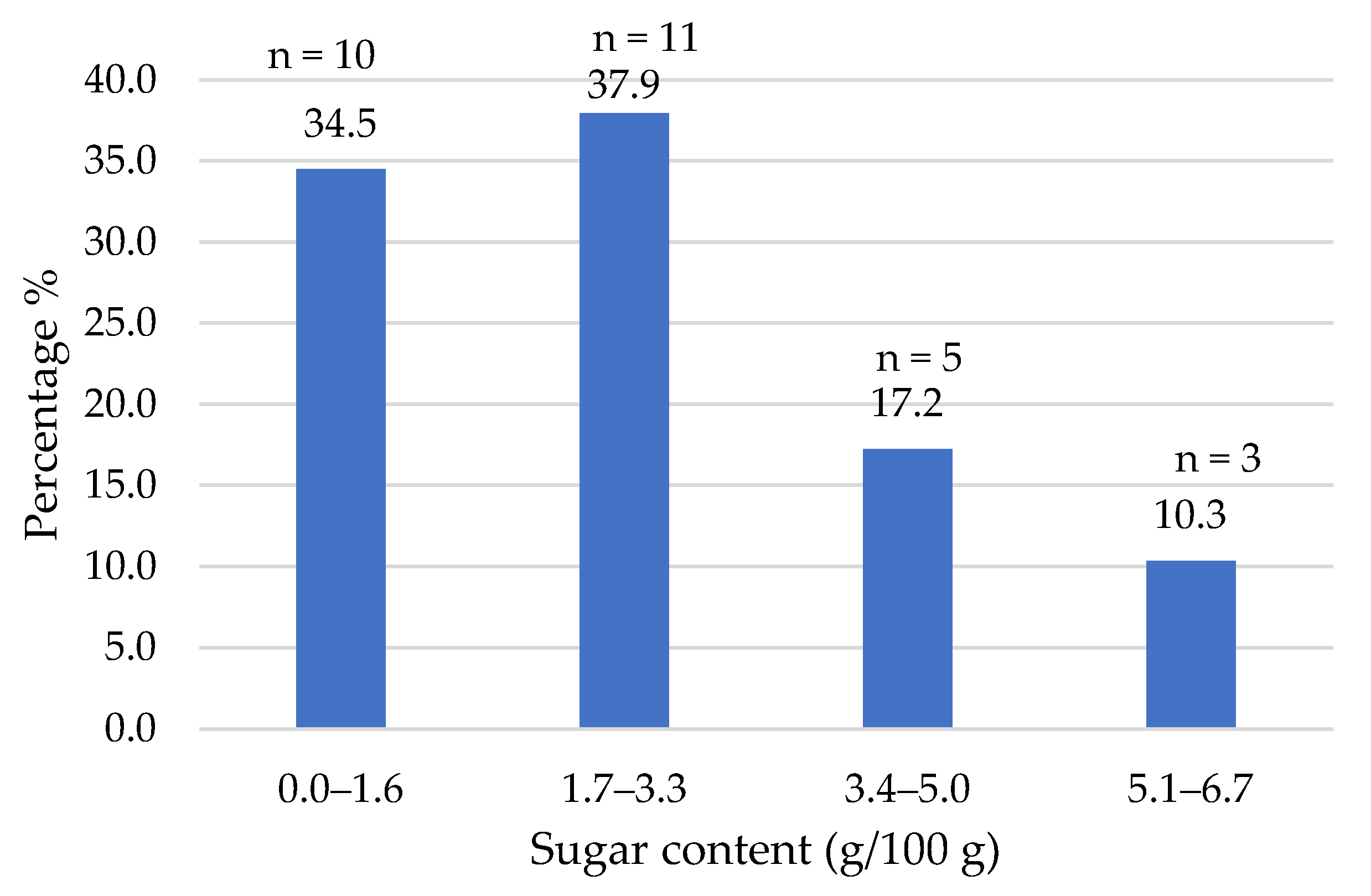
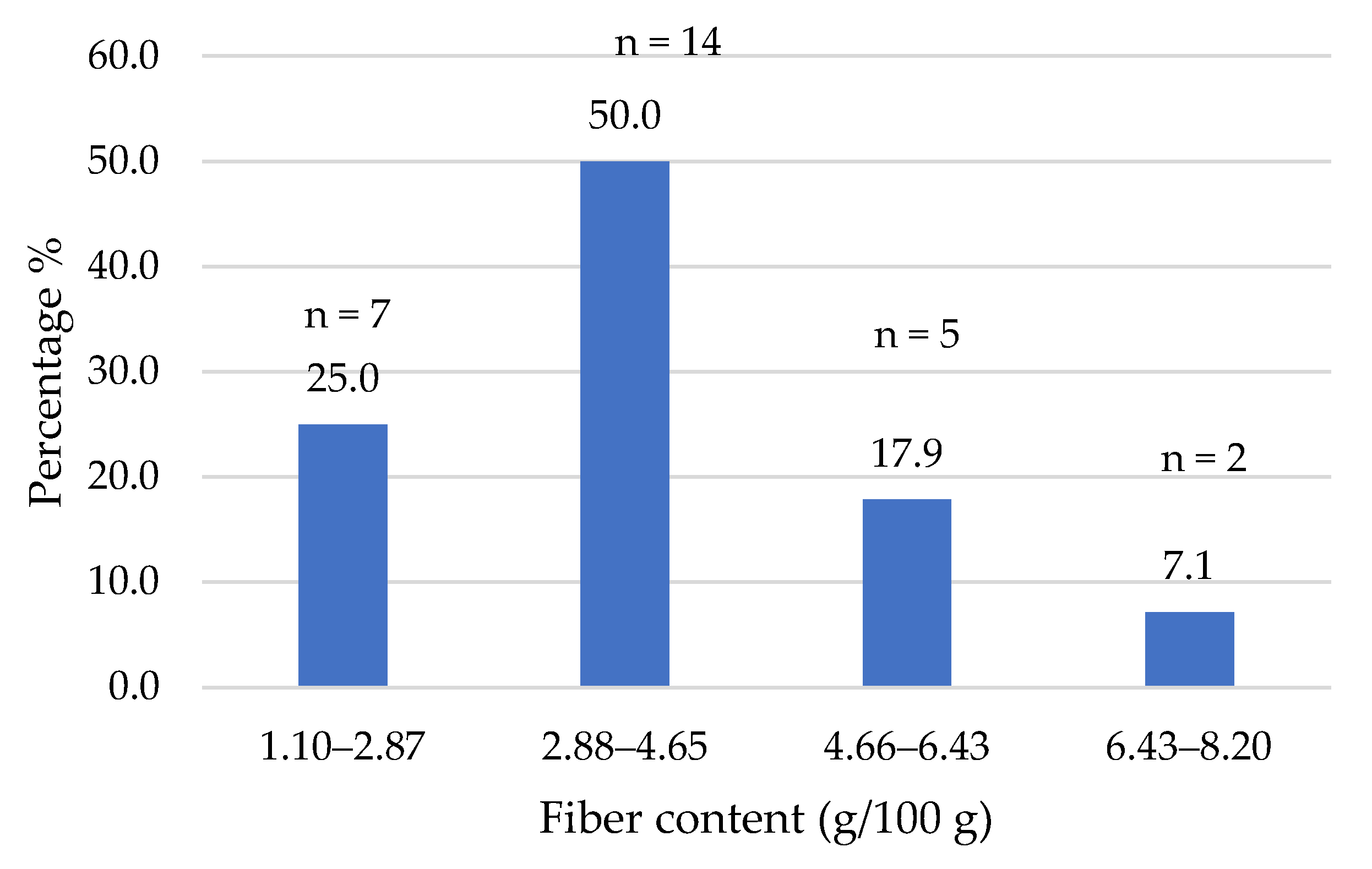
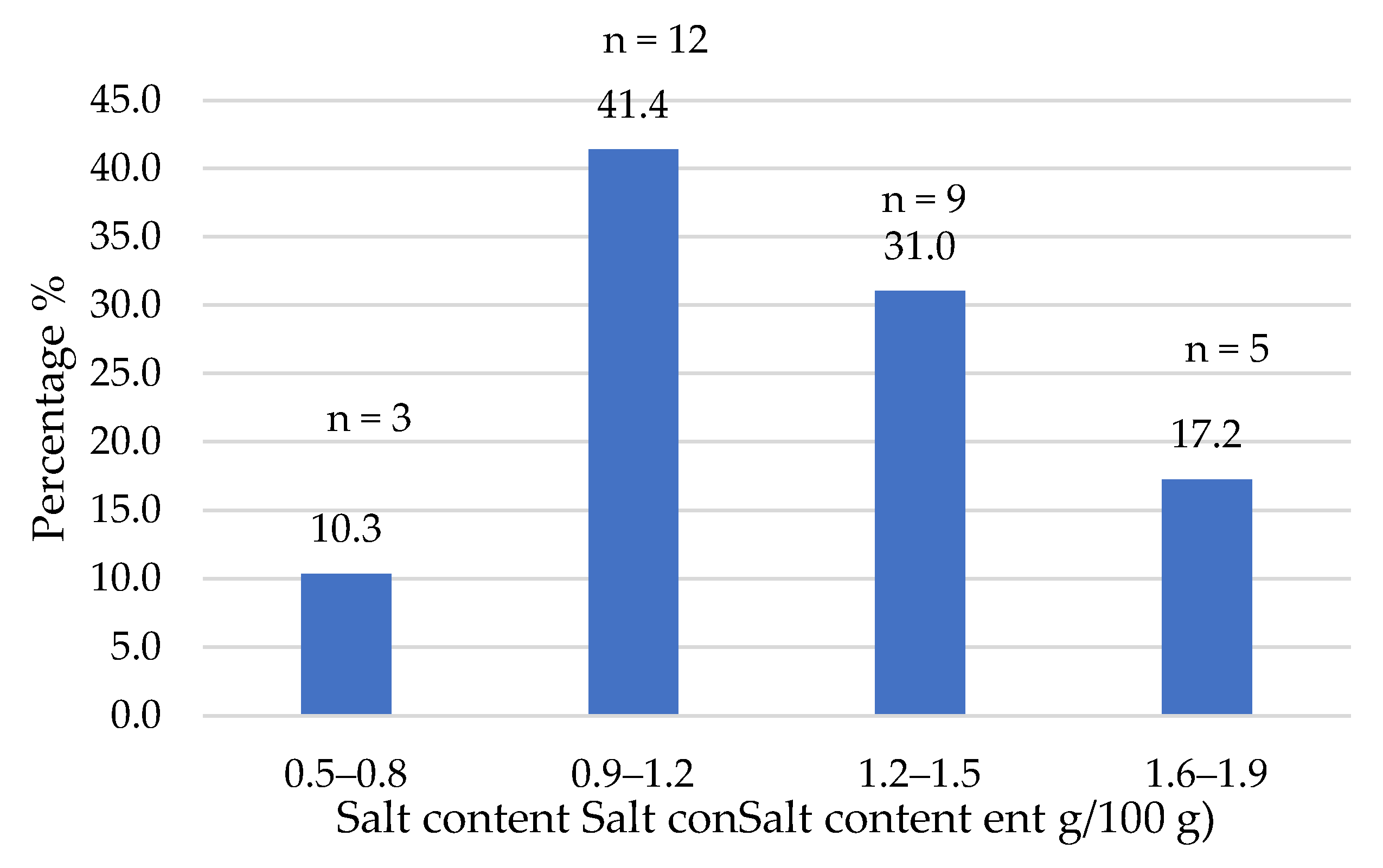
| Brand | Number of Products |
|---|---|
| Soria natural | 5 |
| El Corte Inglés Special Line | 3 |
| Gerblé | 2 |
| Hacendado | 2 |
| Heura | 2 |
| NaturSoy | 2 |
| Vegetalia | 2 |
| Beyond meat | 1 |
| Di que sí | 1 |
| Eroski | 1 |
| Garden gourmet | 1 |
| KoRo | 1 |
| Obrador Sorribas | 1 |
| Schar | 1 |
| Toki | 1 |
| Valsoia | 1 |
| Vemondo | 1 |
| Veritas | 1 |
| Category | Number of Products | Ingredient Description |
|---|---|---|
| Plant Protein Source | 29 | Soy, pea, seitan (wheat gluten), lentils |
| Vegetable Oil | 29 | Rapeseed, coconut, extra virgin olive oil, sunflower, shea fat, canola |
| Vegetables | 29 | Vegetable concentrate, carrot, onion, beetroot, artichoke, mushrooms, zucchini, spinach, eggplant, red bell pepper, hibiscus, tomato |
| Salts | 29 | Sodium chloride, sea salt, Himalayan pink salt, potassium salt |
| Spices | 29 | Ginger, garlic, pepper, nutritional yeast, aromatic herbs, onion powder, parsley, oregano, curry, sweet paprika, turmeric |
| Texturizing Agents | 27 | Methylcellulose, agar-agar, gellan gum, xanthan gum, konjac glucomannan, calcium chloride, nigari (magnesium chloride), gluten |
| Carbohydrate Source | 22 | Wheat, corn, corn starch, barley, whole wheat, tapioca starch, potato starch, rice, oats, potato starch, fermented rice, brown rice, polenta, oat flakes, hydrated wheat bulgur, breadcrumbs, cooked white quinoa, buckwheat flour |
| Yeast/Fermented Products | 18 | Yeast, soy sauce (shoyu-koji ferment), vinegar, fermented rice |
| Aromas | 12 | Natural aroma, smoke aroma |
| Fiber | 8 | Dietary vegetable fiber, soy fiber, vegetable fiber (bamboo, gluten-free oats, psyllium) |
| Colorants | 8 | Beetroot extract, curcuma, cocoa |
| Sugars | 5 | Malt extract, sugar, rice syrup, caramelized sugar syrup, dextrose, cane sugar |
| Algae | 5 | Kombu seaweed, sea spaghetti seaweed |
| Preservatives/Antioxidants | 7 | Potassium sorbate, sodium metabisulfite, citric acid, lactic acid, potassium lactate, ascorbic acid |
| Fruits | 2 | Rehydrated sultanas, dates, apple concentrate, concentrated pomegranate juice |
| Seeds and Nuts | 2 | Toasted sesame, pine nuts, almonds |
| Vitamins | 2 | Vitamin B12 |
| Minerals | 2 | Iron |
| Ingredient | Number of Products | % of Products |
|---|---|---|
| Soy | 21 | 72.4 |
| Wheat | 14 | 48.3 |
| Pea | 8 | 27.6 |
| Lentils | 2 | 6.9 |
| Ingredient | Number of Products | % of Products |
|---|---|---|
| Sunflower | 15 | 51.7 |
| Extra virgin olive oil | 12 | 41.4 |
| Olive oil | 3 | 10.3 |
| Coconut | 2 | 6.9 |
| Canola | 2 | 6.9 |
| Palm | 2 | 6.9 |
| Virgin olive oil | 1 | 3.4 |
| Rapeseed | 1 | 3.4 |
| Shea fat | 1 | 3.4 |
| Energy and Nutrients | Value Per 100 g of Beef Burger |
|---|---|
| Energy (kcal) | 166 |
| Protein (g) | 19.4 |
| Lipids (g) | 9.6 |
| Saturated fats (g) | 4.37 |
| Monounsaturated fats (g) | 4.92 |
| Carbohydrates (g) | 0.6 |
| Water (g) | 67.6 |
| Sodium (mg) | 730 |
| Iron (mg) | 2.2 |
| Zinc (mg) | 5.1 |
Disclaimer/Publisher’s Note: The statements, opinions and data contained in all publications are solely those of the individual author(s) and contributor(s) and not of MDPI and/or the editor(s). MDPI and/or the editor(s) disclaim responsibility for any injury to people or property resulting from any ideas, methods, instructions or products referred to in the content. |
© 2025 by the authors. Licensee MDPI, Basel, Switzerland. This article is an open access article distributed under the terms and conditions of the Creative Commons Attribution (CC BY) license (https://creativecommons.org/licenses/by/4.0/).
Share and Cite
Astiasaran, I.; Flores, S.; Ariz-Hernandez, I.; Ansorena, D. Plant-Based Burgers Commercialized in the Spanish Market: Ingredients and Nutritional Assessment Based on Their Labels. Foods 2025, 14, 3286. https://doi.org/10.3390/foods14193286
Astiasaran I, Flores S, Ariz-Hernandez I, Ansorena D. Plant-Based Burgers Commercialized in the Spanish Market: Ingredients and Nutritional Assessment Based on Their Labels. Foods. 2025; 14(19):3286. https://doi.org/10.3390/foods14193286
Chicago/Turabian StyleAstiasaran, Iciar, Sheila Flores, Itziar Ariz-Hernandez, and Diana Ansorena. 2025. "Plant-Based Burgers Commercialized in the Spanish Market: Ingredients and Nutritional Assessment Based on Their Labels" Foods 14, no. 19: 3286. https://doi.org/10.3390/foods14193286
APA StyleAstiasaran, I., Flores, S., Ariz-Hernandez, I., & Ansorena, D. (2025). Plant-Based Burgers Commercialized in the Spanish Market: Ingredients and Nutritional Assessment Based on Their Labels. Foods, 14(19), 3286. https://doi.org/10.3390/foods14193286









